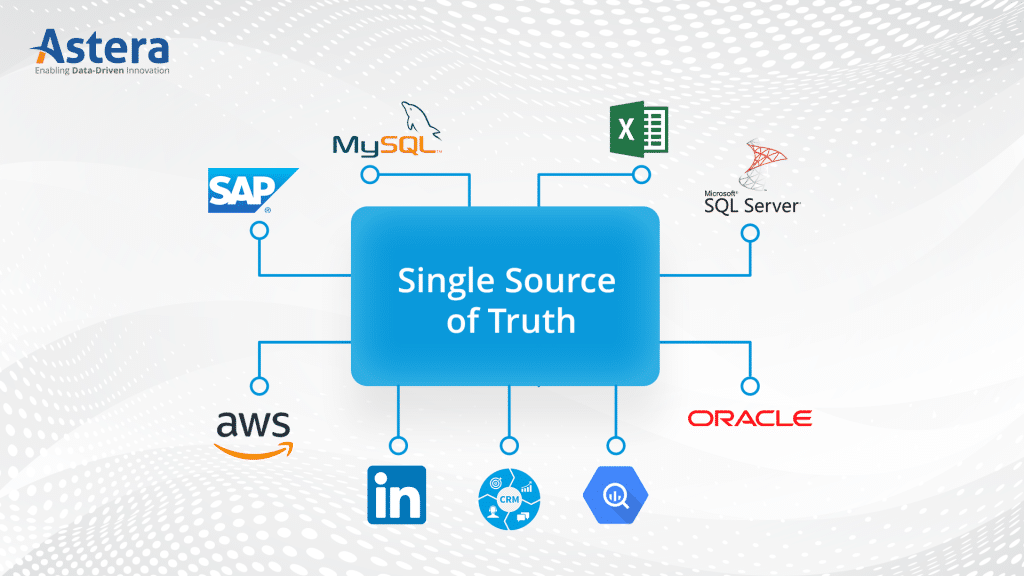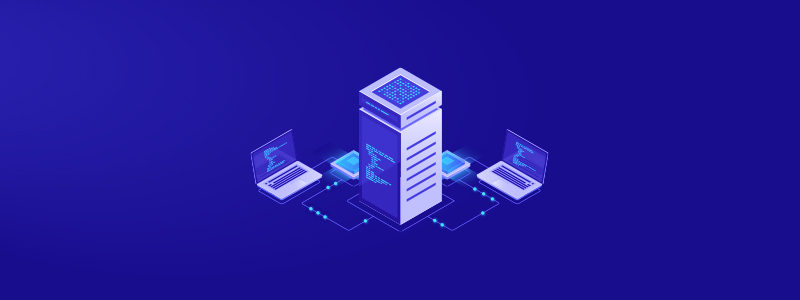
Single Source of Truth: What Is It and Why Is It Essential?
In today’s data-driven world, businesses rapidly generate massive amounts of data. Managing this data effectively and timely is critical for decision-making, but how can they make sense of all this data most efficiently? The answer lies in the concept of a single source of truth (SSOT). This is the key to unlocking the potential of this data, empowering businesses to make sense of it and make accurate business decisions.
In this blog, you will find out what a single source of truth is, how it applies to enterprises, the implementation challenges, and the benefits it offers.
What is a Single Source of Truth?
Within the realm of data management, a single source of truth is a concept that refers to a centralized repository containing an organization’s most accurate, complete, and up-to-date data. This data serves as the organization’s master data and is accessible to anyone who needs it.

Consider this scenario: The inventory team reports that a product is in stock, but the warehouse team insists it’s sold out. Meanwhile, customer service is dealing with frustrated buyers who were promised next-day delivery. When different teams rely on conflicting data, confusion and inefficiencies accumulate. The outcome can be made favorable if everyone works with the same, accurate information—preventing discrepancies and keeping operations running smoothly.
In short, a single source of truth serves as the centralized data repository containing the most accurate and up-to-date data that everyone can use for data-driven initiatives.
How Does This Apply to Modern Enterprises?
Global enterprises have data scattered across different business units, and then further spread across different departments with every department having its own central repository. These repositories can be called ‘departmental’ sources of truth. Team members heavily depend on these repositories for decision-making, reporting and visualizing data, and other business intelligence activities.
So where does it leave the enterprise? With every department operating in an isolated silo, the data they base their decisions on is mostly inconsistent, inaccurate, and not up to date. This is when it becomes vital to implement a truly single source of truth. A single source of truth contains the master data and enables data sharing across different departments and business units.
However, to establish a SSOT, enterprises have to combine data from different sources, which is often tedious and time-consuming. Because this data is in different formats, transforming it and improving its quality is of prime importance before loading it into a data warehouse.
Challenges of Implementing a Single Source of Truth
While a SSOT is a necessity, there are many challenges that enterprises face in adopting it.
Integrating data from multiple sources
According to a survey by Market Pulse, organizations have more than 400 data sources on average. As if that’s not enough, many global businesses have data coming in from more than a thousand sources!
The data from these sources have different formats, structures, and standards, making it an arduous endeavor for data engineers and professionals. They have to ensure that the data is mapped correctly, transformed as required, and loaded into the destination without any errors.
Integrating data from these many sources is a formidable challenge on its own, and this is precisely where an automated data integration platform can help.
Ensuring data quality
Another major challenge is implementing robust data quality management. A single source of truth will only be as reliable as the data it contains. Because the data comes in from disparate sources and in different formats, it’s critical to set up data quality checks.
Data professionals will need to ensure that the data is accurate, complete, and consistent before it makes its way to the target destination.
Ensuring data security
Similar to how a single source of truth is an ongoing approach, ensuring data security is also a continuous process that requires constant monitoring to protect data from cyberattacks. Many enterprises operate in highly regulated industries where data security is of utmost importance, such as healthcare and finance.
While implementing a single source of truth, enterprises must ensure that they comply with all the required regulations like HIPAA, GDPR, etc. Because the data is available across the enterprise, these regulations require organizations to keep a strict control over their data assets. This includes setting up and managing access controls so that every person only accesses the data they need to perform their tasks.
Gaining stakeholder buy-in
Getting buy-in from stakeholders on a new process, system, or approach that will impact their day-to-day operations is another major challenge. Similarly, implementing a single source of truth will mean that departments will have to change the way they work which also involves changing the processes and systems that the stakeholders are used to.
Therefore, it is important to communicate and reiterate the incredible benefits of these changes.
A Roadmap to Implement a Single Source of Truth
To implement a SSOT, organizations must rethink their data strategy and address the cultural shift needed. Typically, this involves aligning business processes with technology and ensuring all stakeholders are on the same page. This means carefully selecting interoperable technologies and designing a sustainable data integration architecture that ensures ongoing data synchronization and adaptability to future needs.
Here are key considerations and initial steps to guide the implementation of a single source of truth:
Conduct a deep data inventory
A comprehensive data inventory goes beyond a superficial audit. Organizations should:
- Map every dataflow and record dependencies across departments.
- Assess data formats, frequency of updates, and quality using advanced profiling tools.
- Document data lineage to trace its origin and evolution.
This understanding helps identify discrepancies and gaps that could undermine future integration efforts.
Target high-impact data domains
A successful SSOT strategy focuses on areas that drive core business processes. Rather than attempting a full-scale overhaul in one go, it is recommended to:
- Identify critical data sets—such as customer records, product information, and vendor details—that directly impact operations.
- Phase the integration process, starting with these high-impact areas to build momentum and demonstrate early value.
- Standardize data definitions to ensure consistency across the organization.
This targeted approach turns isolated data silos into a cohesive, actionable repository.
Design a customized, scalable architecture
Choosing the right technology is critical. Rather than relying on off-the-shelf solutions, organizations should:
- Evaluate the complexity and volume of their data to determine the ideal architecture—be it data warehousing, data lakes, or specialized master data management (MDM) systems.
- Ensure the chosen solution supports real-time analytics and integrates with existing systems.
- Plan for scalability to accommodate future growth and evolving data sources.
A tailored, forward-thinking architecture maximizes performance and flexibility.
Institutionalize continuous data quality practices
Since maintaining data integrity is an ongoing process, organizations should:
- Implement automated validation and cleansing mechanisms to catch errors in real time.
- Establish routine quality assessments and user feedback channels to adapt to emerging challenges.
- Utilize predictive analytics to foresee potential quality issues before they impact operations.
A proactive stance on data quality ensures the SSOT remains a reliable foundation for decision-making.
Enforce robust governance and security controls
A well-governed single source of truth is not only accurate—it’s secure. Therefore, organizations should:
- Define clear data stewardship roles and responsibilities across teams.
- Develop comprehensive policies for data maintenance, including version control and audit trails.
- Implement role-based access controls to balance broad accessibility with the need to protect sensitive information.
Governance safeguards the integrity of the centralized data and builds trust among all stakeholders.
Different Ways to Achieve a Single Source of Truth
Organizations can achieve a SSOT through a variety of strategies, each tailored to their unique data landscape and operational needs. Here are some approaches:
Enterprise service bus (ESB) integration
An ESB facilitates real-time or near-real-time data exchange between disparate systems. It acts as a central messaging hub to ensures that updates from various sources are aggregated into a central repository.
Data warehousing with ETL processes
Traditional data warehousing involves extracting, transforming, and loading (ETL) data from multiple source systems into a central database. This approach is particularly effective for analytical reporting and historical analysis.
Master data management (MDM)
MDM systems focus on consolidating and governing key data domains—such as customer, product, or supplier data—ensuring that these core datasets are accurate, consistent, and available across the organization.
Data lakes combined with data virtualization
Modern architectures sometimes store raw, unstructured data in data lakes. Data virtualization tools then provide a unified, logical view of this information, allowing users to access a single, consolidated data set without moving all data physically.
API-led connectivity
Organizations can expose and integrate data via standardized APIs. API-led connectivity enables systems to share data seamlessly and supports agile, scalable integration across various applications.
Event-driven and real-time streaming architectures
By capturing data as it changes through real-time streaming, organizations can immediately propagate updates to a central hub. This ensures that the SSOT reflects the most current information available.
Hybrid approaches
Many organizations opt for a mix of these methods. For example, an MDM system might handle core business data, while an ESB or API-driven approach manages transactional updates. Combining techniques allows companies to address the specific challenges of different data types and use cases.
Benefits of a Single Source of Truth
Enterprises deal with formidable challenges in pursuit of a SSOT, but once it’s implemented, it offers numerous benefits. These include:
Breaking down data silos
One of the biggest benefits of creating a single source of truth is that it eliminates data silos. Instead of being scattered across the enterprise, the most accurate and up-to-date data is available in a centralized location.
Eliminating redundant data
When different teams work with different sources of data, it leads to data redundancy and errors. A single source of truth, on the other hand, eliminates redundancy and guarantees data accuracy, enabling teams to make more informed decisions.
Increasing collaboration and productivity
A single source of truth means that every team uses the same data source for decision-making, reporting, or other BI initiatives. This further enables teams to collaborate more effectively since everyone has the same data set to work with. Needless to say, effective collaboration leads to higher levels of productivity.
Promoting transparency
Another advantage of having a single source of truth is that it builds and promotes the culture of transparency across the enterprise. Everyone with the same access level can access the same data to work with. Furthermore, it enables teams to monitor how their efforts contribute to the overall organizational goals.
How does a Modern Data Integration Platform fit in?
By incorporating a modern data integration platform, such as Astera, into their data stacks, enterprises can effectively deal with most of the challenges they face in implementing a single source of truth.
Astera offers a 100% no-code data integration platform powered by AI-driven automation. It accelerates the process of combining data from multiple sources into a single repository, empowering enterprises to make faster, more informed decisions.
Here’s why enterprises use Astera to achieve a single source of truth:
- Native connectors: With a wide range of native connectors, combining data from multiple sources is just a matter of point and click
- Data quality: Astera offers advanced data quality features to ensure your single source of truth is powered by healthy data
- Ease of use: Astera’s intuitive, drag-and-drop UI makes it easy for users to build ETL/ELT pipelines without writing a single line of code
- Automation: Build data pipelines once and use job scheduler and workflow orchestration to automate the data integration process
If your enterprise is considering to build a single source of truth, call +1-888-77-ASTERA to talk to one of our data integration experts or download a 14-day free trial and get started today!
 Astera AI Agent Builder - First Look Coming Soon!
Astera AI Agent Builder - First Look Coming Soon!


